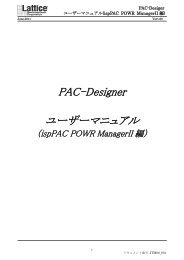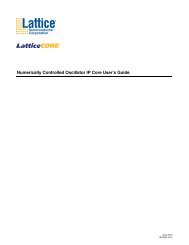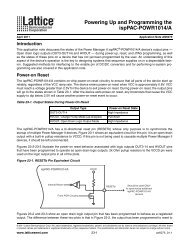DS1036 - Platform Manager Data Sheet - Lattice Semiconductor
DS1036 - Platform Manager Data Sheet - Lattice Semiconductor
DS1036 - Platform Manager Data Sheet - Lattice Semiconductor
Create successful ePaper yourself
Turn your PDF publications into a flip-book with our unique Google optimized e-Paper software.
FPGA Architecture Details<br />
54<br />
<strong>Platform</strong> <strong>Manager</strong> <strong>Data</strong> <strong>Sheet</strong><br />
The <strong>Platform</strong> <strong>Manager</strong> FPGA architecture contains an array of logic blocks surrounded by Programmable I/O<br />
(PIO). Figure 39 shows the block diagrams of the FPGA block.<br />
The logic blocks are arranged in a two-dimensional grid with rows and columns. The PIO cells are located at the<br />
periphery of the device, arranged into banks. The PIOs utilize a flexible I/O buffer referred to as a sysIO interface<br />
that supports operation with a variety of interface standards. The blocks are connected with many vertical and horizontal<br />
routing channel resources. The place and route software tool automatically allocates these routing<br />
resources.<br />
There are two kinds of logic blocks, the Programmable Functional Unit (PFU) and the Programmable Functional<br />
unit without RAM (PFF). The PFU contains the building blocks for logic, arithmetic, RAM, ROM, and register functions.<br />
The PFF block contains building blocks for logic, arithmetic, ROM, and register functions. Both the PFU and<br />
PFF blocks are optimized for flexibility, allowing complex designs to be implemented quickly and effectively. Logic<br />
blocks are arranged in a two-dimensional array. Only one type of block is used per row.<br />
The FPGA JTAG port supports programming and configuration of the FPGA as well as access to the user logic.<br />
Figure 39. Top View of the FPGA Section<br />
PFU Blocks<br />
Programmable<br />
Function Units<br />
with RAM (PFUs)<br />
FPGA JTAG Port<br />
PIOs Arranged into<br />
sysIO Banks<br />
Programmable<br />
Function Units<br />
without RAM (PFFs)<br />
The core of the FPGA section consists of PFU and PFF blocks. The PFUs can be programmed to perform Logic,<br />
Arithmetic, Distributed RAM, and Distributed ROM functions. PFF blocks can be programmed to perform Logic,<br />
Arithmetic, and Distributed ROM functions. Except where necessary, the remainder of this data sheet will use the<br />
term PFU to refer to both PFU and PFF blocks.<br />
Each PFU block consists of four interconnected slices, numbered 0 to 3 as shown in Figure 40. There are 53 inputs<br />
and 25 outputs associated with each PFU block.









